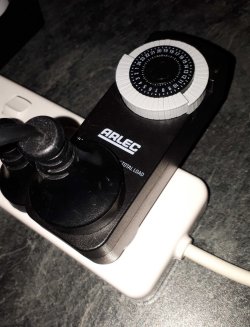Starting with the air...you do not want surface disturbance running during the day and not at night. Leave it on full time. Plants need adequate light (intensity and spectrum) balanced with all 17 nutrients--one of which is carbon which most of them take up as CO2 from the water (or air for floating plants). Surface disturbance from filters and air stones will promote the gas exchange (oxygen and CO2) in the tank, which is fine, unless it is too great and starts dissipating out the CO2 before the plants can use it. At night, the natural respiration of fish, plants, and some bacteria species, along with decomposition of organics in the substrate primarily, will release CO2. The CO2 rebuilds during the night, so when daylight occurs and plants need to photosynthesize they have sufficient CO2. But if you run unnecessary airstone at night, you risk losing some of the much-needed CO2, and carbon is a macro-nutrient for plants.
This can be an issue during the day as well, but that depends upon the plant load, surface disturbance, light, and nutrient availability. And by the way, the above is why the pH has what is termed a diurnal fluctuation; it will be lowest in the very early morning, after the CO2 has rebuilt during the night, and highest at the end of the daylight when the plants have used most all of the CO2. This also governs your light.
Plants need adequate intensity and spectrum of light to drive photosynthesis. But photosynthesis will only occur if all nutrients are available to the plants. This is where we work out the light duration. If everything is available, the plants will photosynthesize full out, and problem algae will be thwarted. But as soon as something essential runs out--and this is most often the CO2--photosynthesis slows and may even cease. If the light remains on, problem algae is home free and will use the advantage.
Tropical aquatic plants do not need 12 hours of light, they adjust very well. But they do need everything in the equation, light and nutrients. If you have ever seen videos taken underwater in almost any watercourse in South America, you will see algae covering everything. The plants have fewer nutrients but stronger light, and that means algae.
The "daylight" period is the period of strongest white light. It can be at any time of day, but it must be consistent. And, not beyond the available nutrients. In my fish room of 8 tanks, I worked out the balance to be 7 hours, and for the following years I had no problem algae at all, whereas previously it came and went, mostly came, because the light was on too long and there were insufficient nutrients.


